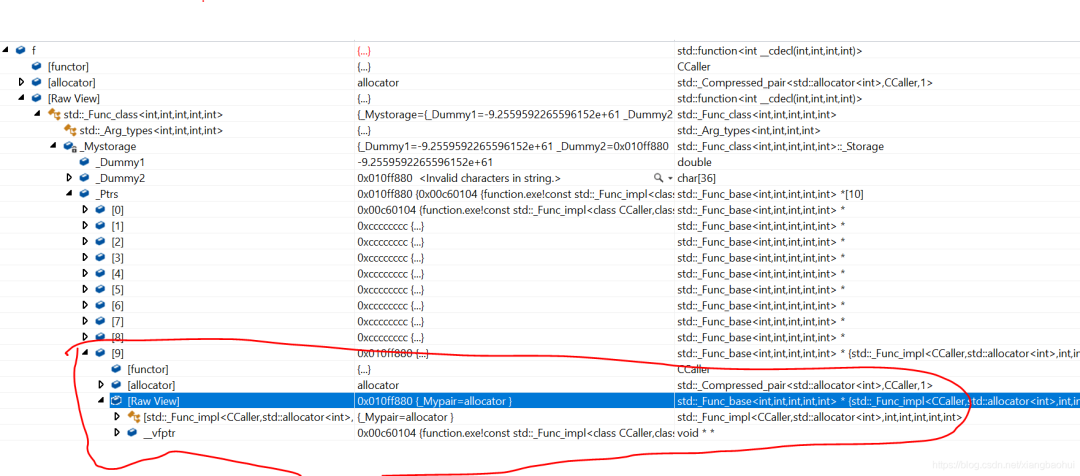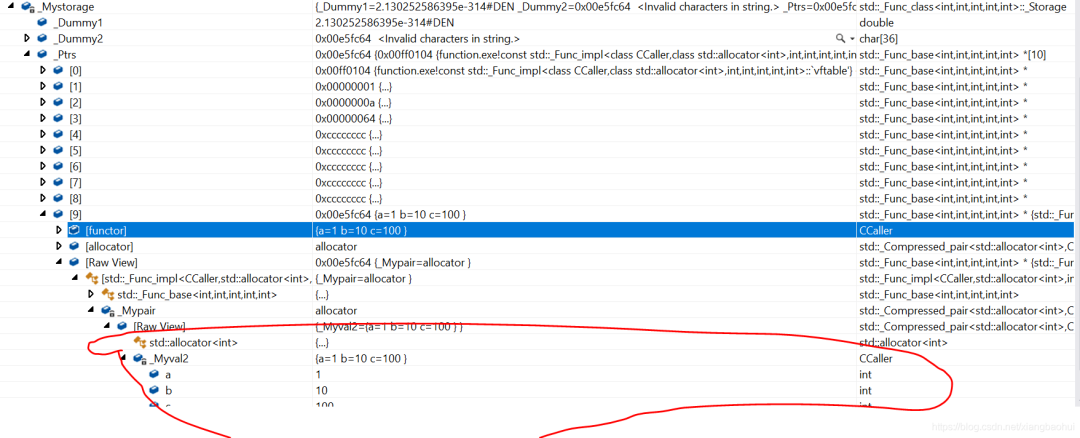

C++ function技术的实现与具体运用
描述
【导读】:本文主要讲解C++ function技术的实现与具体运用。
std::function是一个函数对象的包装器,std::function的实例可以存储,复制和调用任何可调用的目标,包括:
函数。
lamada表达式。
绑定表达式或其他函数对象。
指向成员函数和指向数据成员的指针。
当std::function对象没有初始化任何实际的可调用元素,调用std::function对象将抛出std::bad_function_call异常。
本文我们来谈一下std::function的实现原理。
1. std::function简介
在讨论其原理的时候,我们来熟悉一下这个东西是怎么使用的,C++标准库详细说明了这个的基本使用http://www.cplusplus.com/reference/functional/function/.
这里我们大概总结一下。
1.1 Member types
| result_type | 返回类型 |
| argument_type | 如果函数对象只有一个参数,那么这个代表参数类型。 |
| first_argument_type | 如果函数对象有两个个参数,那么这个代表第一个参数类型。 |
| second_argument_type | 如果函数对象有两个个参数,那么这个代表第二个参数类型。 |
| 成员类型 | 说明 |
|---|
1.2 Member functions
| constructor | 构造函数:constructs a new std::function instance |
| destructor | 析构函数:destroys a std::function instance |
| operator= | 给定义的function对象赋值 |
| operator bool | 检查定义的function对象是否包含一个有效的对象 |
| operator() | 调用一个对象 |
| 成员函数声明 | 说明 |
|---|
1.3 基本使用
#include
从上面我们可以发现,std::function可以表示函数,lamada,可调用类对象。
2. std::function实现
在标准库中STL设计为如下:
template
上面的std::function继承关系比较简单,主要使用
union _Storage { // storage for small objects (basic_string is small) max_align_t _Dummy1; // for maximum alignment char _Dummy2[_Space_size]; // to permit aliasing _Ptrt *_Ptrs[_Num_ptrs]; // _Ptrs[_Num_ptrs - 1] is reserved };
这个来存储我们设置的可调用对象,我们从std::function的使用过程看一下整个原理。
2.1 函数对象赋值
我们使用的时候一般使用f = Caller;来设置函数对象,我们看下这个的实现过程。
template
我们看this->_Reset(_Func)这个函数,因为这个才是设置函数可调用对象的东西。
void _Set(_Ptrt *_Ptr) _NOEXCEPT { // store pointer to object _Mystorage._Ptrs[_Num_ptrs - 1] = _Ptr; } void _Reset_impl(_Fx&& _Val, const _Alloc& _Ax, _Myimpl *, _Alimpl& _Al, false_type) { // store copy of _Val with allocator, small (locally stored) _Myimpl *_Ptr = static_cast<_Myimpl *>(_Getspace()); _Al.construct(_Ptr, _STD forward<_Fx>(_Val), _Ax); _Set(_Ptr); } template
这个代码的主要意思就是创建一个_Func_impl<_Decayed, _Alloc, _Ret, _Types...>指针,然后赋值_Mystorage._Ptrs[_Num_ptrs - 1] = _Ptr;。
设置之后,我们看下调用操作怎么完成。
2.2 operator() 的实现
调用操作主要是通过operator()来实现的,我们看下这个的实现过程。
_Ptrt *_Getimpl() const _NOEXCEPT { // get pointer to object return (_Mystorage._Ptrs[_Num_ptrs - 1]); } _Ret operator()(_Types... _Args) const { // call through stored object if (_Empty()) _Xbad_function_call(); return (_Getimpl()->_Do_call(_STD forward<_Types>(_Args)...)); }
因此,我们是通过_Func_impl<_Decayed, _Alloc, _Ret, _Types...>转发了调用操作_Do_call
2.3 _Func_impl的实现
class _Func_impl : public _Func_base<_Rx, _Types...> { // derived class for specific implementation types public: typedef _Func_impl<_Callable, _Alloc, _Rx, _Types...> _Myt; typedef _Func_base<_Rx, _Types...> _Mybase; typedef _Wrap_alloc<_Alloc> _Myalty0; typedef typename _Myalty0::template rebind<_Myt>::other _Myalty; typedef is_nothrow_move_constructible<_Callable> _Nothrow_move; virtual _Rx _Do_call(_Types&&... _Args) { // call wrapped function return (_Invoke_ret(_Forced<_Rx>(), _Callee(), _STD forward<_Types>(_Args)...)); } _Compressed_pair<_Alloc, _Callable> _Mypair; };
_Func_impl这个类通过_Do_call来转发函数对象的调用操作。
3. 总结
这里我们看下std::function的结构信息,如下:

从这里我们发现_Storage大小为:
const int _Num_ptrs = 6 + 16 / sizeof (void *); const size_t _Space_size = (_Num_ptrs - 1) * sizeof (void *);
_Num_ptrs值为10。
如果我们赋值的对象有成员变量会是什么情况呢?例如如下:
class CCaller { public: int operator()(int a, int b, int c, int d) { std::cout << a << std::endl; std::cout << b << std::endl; std::cout << c << std::endl; std::cout << d << std::endl; return 0; } int a = 1; int b = 10; int c = 100; }; int main() { CCaller Caller; std::function
内存结构如下:

由此我们可以发现std::function是利用一个_Compressed_pair<_Alloc, _Callable> _Mypair;拷贝了元素的数据信息。
主要的初始化过程为:
emplate
其中decay<_Fx>::type定义了_Compressed_pair<_Alloc, _Callable> _Mypair;中_Callable的类型,这个声明如下(也就是去掉引用和其他属性信息):
template
至此,我们大致上完成了std::function的原理分析了,希望在后续的使用中,我们能够知道std::function在什么情况下可以使用,以及背后完成的事情。
责任编辑:lq
-
请问C++如何运用到具体的工程中?2020-03-24 2057
-
上位机通信协议控制电机上位机C++实现上位机62021-09-16 2205
-
C语言C++运用2021-11-25 5618
-
如何利用C++也实现RMI功能2010-11-17 782
-
C++内部类的实现及应用2011-06-28 805
-
基于C++的modbus通讯协议模型实现2016-03-21 1830
-
运用Visual C++ 5.0或6.0的高级编程技巧,内容涉及MFC程序设计的最新概念2017-09-04 914
-
高级C/C++编译技术2017-12-04 1614
-
C++程序设计教程之C++的初步知识的详细资料说明2019-03-14 1249
-
讲解C++ function 技术的实现与具体运用2021-01-19 5325
-
C++常见设计模式解析与实现2021-06-01 836
-
在C++中如何用虚函数实现多态2021-09-29 2139
-
虚拟机的设计与实现:C\C++2022-02-21 920
-
C++简史:C++是如何开始的2024-01-11 1450
-
C++中实现类似instanceof的方法2024-07-18 1315
全部0条评论

快来发表一下你的评论吧 !

